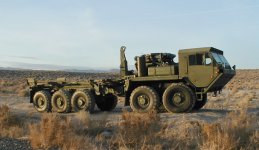



With the heavy tactical wheeled vehicle fleet fast approaching the end of its service life, the Marine Corps is enlisting ideas from industry to find the best approach for a replacement - one that will contain total ownership costs. The Marine Corps seeks dialogue with industry to ensure that program and performance goals are realistic. The Marine Corps intends to use industry's feedback to develop an LVSR solicitation package for full and open competition. The target date for Initial Operational Capability is 2008. Cost will depend upon availability of a system that meets Marine Corps needs and is ready for testing. If industry can provide cost effective alternatives, then costs may be contained. If a full scale developmental program is needed, then costs may exceed $1 Billion. In any case, cost reduction strategies, reliability & maintainability improvement initiatives, and life cycle support recommendations are encouraged.The Logistics Vehicle System Replacement (LVSR) will replace the current Marine Corps heavy tactical wheeled vehicle, the Logistics Vehicle System (LVS). The LVSR is envisioned as a heavy tactical logistics distribution system that transports bulk liquids, ammunition, ISO containers up to 20ft in length, tactical bridging and support equipment, and bulk/breakbulk cargo; performs wrecker/recovery duties; and tows semi-trailers carrying heavy/oversized equipment (engineer and combat).
A sampling of the performance goals sought are:The Marine Corps has completed fabrication of a technology demonstrator. State-of-the-art, commercially available automotive technology was integrated onto an existing LVS platform, electronically linked to provide diagnostic and prognostic communication, and modeled against the current LVS to demonstrate performance improvements. Testing will be conducted February through August 2000. The Marine Corps intends to use lessons learned from these early concept exploration efforts to build a performance-based system requirement document and to share information with potential manufacturers.
- Minimum 22.5 ton on-road payload
- Towed loads of up to 200,000 lbs. Gross Combined Vehicle Weight
- On and off-road capability
- Room for a two man crew, personnel protective gear, and M16A2 rifles
- Crew survivability against ballistic and mine threats
- ISO container compatibility
- No reliance on external materiel handling equipment
- Range of at least 300 miles
- Transportable on amphibious and commercial shipping, rail and C141B aircraft
- Externally transportable by CH-53E helicopter (max weight 28,000 lbs)
- Ease of maintenance
- Corrosion resistant
- Interface with:
- Marine Corps semitrailers
- US Army Palletized Load System (PLS) flatracks
- US Army Container Roll-on/Roll-off Platform (CROP)
Specifications
